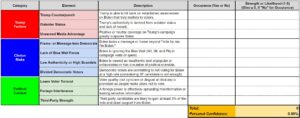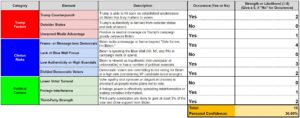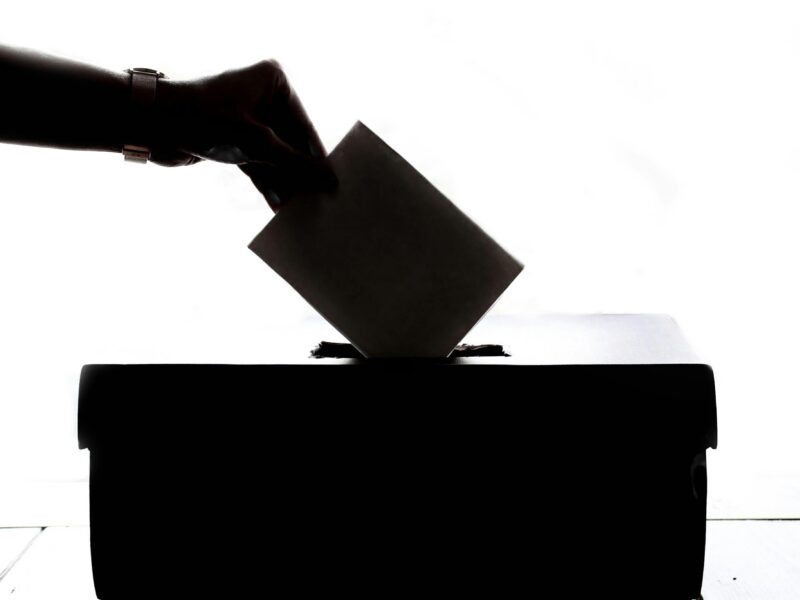Plainly, yes. And this is not a sarcastic or pessimistic “anything is possible” type of yes. It is a legit yes. Biden can win this election and has a fully viable path to victory.
Since The Real Question is focused on analysis, data, and being realistic, you are probably wondering why I’m starting this blog with that tone. Believe me, I would rather have a different and more neutral approach at this stage in the election. Obviously from my other political blogs, I voted for Biden, will vote for him again, and am not a fan of his predecessor. However, when it comes to strategic analysis, I don’t want you to ever think my conclusions are driven purely by my preferences or biases. Even the title “Can Biden Win?” screams that I’m about to deliver a Democratic Party pep rally or some election hopium.[i] But no. If Biden truly didn’t have a path to victory at this point, I would tell you honestly.
I’m taking this tone because everyone thinks Biden is sure to lose. Of course that is only anecdotal. Yet in my research, interactions with family and friends, and overall observation, it’s hard to find an opposing sentiment that isn’t just a hot take or someone toeing the party line. 538, the popular election forecasting site, has at best been ambivalent on Biden’s chances by giving slight advantages to Biden and Trump at various times since launching their prediction model.[ii] However, Trump advisors are feeling so confident that they’re trying to expand the electoral college map to . . . New Jersey?[iii]
So, my hand is forced to start from the perspective that Trump will win and examine whether my preferred candidate Biden still has a realistic path toward victory. Despite this starting point, there still needs to be an analytical structure for this analysis. Otherwise, this post will become just as homogenous as the flood of punditry available on larger platforms.
To do this, we’ll revisit 2016 and 2020. It is not often that a candidate runs this many times in a row enlisting the same strategy every time. So no, with these parameters, let’s take a holistic view of how this strategy was successful in 2016, yet unsuccessful in 2020. Through this comparative historical analysis, we can examine the anatomy of a Trump win and see how it applies to 2024.
You might be wondering, “What if Trump doesn’t need a 2016-style election to win in 2024?” If true, then this analysis would not be too helpful. However, I feel confident that this will be the case for now, given that Trump is still being Trump. Additionally, it is standard re-election strategy to reassemble the core audience of voters and supporters who initially put you in the first place. This implies getting voters into the same mindset as past elections, which is a combination of candidates, framing, and political environment. Therefore, as of right now, I’m not sure how else Trump would win without replicating the circumstances of 2016. However, I pledge to come back and update this post if other political elements emerge to alter this thinking.
Don’t worry though, this will not be a long study into demographics, polling, and other election math. It is still too early for that. And honestly, I only plan on discussing that topic one time during our current election cycle.
Instead, this post will focus on how to build informed intuition on the upcoming presidential election. I’ll also reveal in this post the 2024 Election Scorecard. With this tool, you can revise your election assumptions multiple times throughout the year and gain a better understanding of your predictions for this election.
Keep in mind that this post is not an election prediction. Should I choose to make a prediction for this cycle, it will be on Election Day like I did for the 2020 presidential election and the 2021 Georgia U.S. Senate runoff. I’m still very proud of how accurate those election predictions turned out, although my electoral college map was a bit too optimistic.
With that, let’s get started . . .
Trump’s Only Tactic: The Trump Counterpunch
Before we jump back into 2016 and 2020, we need to go into detail about a key Trump tactic. In mid-1970s New York, Donald Trump was trying to enter Manhattan real estate and needed a mentor and a lawyer.[iv] Roy Cohn filled both roles. Cohn was a prosecutor in the Rosenberg Trial, a “chief architect” of McCarthyism and the Lavender Scare, and represented Nancy Reagan, the Roman Catholic Archdiocese of New York, Carmine Galante, “Fat Tony” Salerno, and of course, Donald Trump.[v]
Fun Fact: The West Virginia State Bar offers a continuing legal education class called, “Lessons in Ethics: The Evil Lawyer Roy Cohn.”[vi] . . . So there’s that.
Cohn and Trump first worked together defending against claims of racial discrimination in Trump’s rental practices (which I’m sure is shocking to hear) by the federal government.[vii] Cohn advised Trump to deny all wrong and instead counterpunch by filing a countersuit against the government, which he did.[viii] The case settled out of court because of all the “damning evidence of racial discrimination” with Trump admitting no wrongdoing and declaring a victory.[ix] This is Trump’s first major use of his trademarked “denial and counterpunch” approach.
Trump also learned incredible message discipline, ultimately becoming the type of person who lives by the motto “if you repeat something enough, people will start to believe it.”[x] Repeating these tactics over the years, Trump adopted his core methodology for how to fight in the media and courts.[xi] The former of which is a key skill in getting elected to office. This cycle of denial, always counterpunching, and message repetition is the general foundation of the “Trump Counterpunch.”
Typically counterpunching is a political tactic used to thwart incoming attacks. It has been used for decades, primarily as a way to keep the voters’ focused on the candidate’s core message. The two best examples of this are: 1) Sen. Lloyd Bentson’s “You’re no Jack Kennedy” counterpunch on Vice President Dan Quayle in the 1988 Vice Presidential Debates[xii] and 2) Ronald Reagan countered perception issues about his age by saying he would not “exploit for political purposes my opponent’s youth and inexperience” in the 1984 Presidential Debates.[xiii] Mondale even laughed at the humor in Reagan’s counterpunch.[xiv]
While those two examples are in debates, candidates counterpunch in interviews, ads, and in other media. Counterpunches can be well-planned maneuvers or deployed spontaneously. Overall, counterpunching is usually a targeted tactic to keep the media and public focused on more impactful messaging.
Trump, on the other hand, never misses an opportunity to counterpunch on everything, usually counterpunching on the same issues his opponents attack him on. If the Trump Counterpunch is gaining traction with voters, then it will become a repeated attack. This can cause Trump’s opponents to lose focus on their message and fight on his terms, thus surrendering the whole framing of the election.
In many ways, this is Trump being Trump. And his staunchest allies applaud him for his lack of strategic agility.[xv] Opponents can count on heavy use of the Trump Counterpunch when running against him and expect light use and lower prioritization of other political strategies and tactics. If Trump’s counterpunch isn’t strong, then he’s starting with a major problem.
2016 vs. 2020
With all due respect to Hillary Clinton, the first and still only female candidate to win a U.S. major party’s presidential nomination, unfortunately she was the perfect foil for Donald Trump in 2016. Her issues as a candidate and Trump’s novelty led to the strongest form of the Trump Counterpunch we’ve seen.
Due to a long career marked by scandal and partisan congressional investigations, there was plenty for Trump to use to counterpunch Clinton. She would call him corrupt, and Trump would hit on her emails. Clinton attacked him on racial issues, and he called her a “bigot.”[xvi] She attacked him on foreign policy, and Trump hit her on the Middle East and Benghazi.[xvii] Clinton calls him unfit for office, and he attacks her use of a private email server that triggered an FBI investigation and health issues at the 9/11 observance.[xviii] She calls him an unscrupulous businessman for Trump University,[xix] and Trump hits back on Clinton Foundation fundraising,[xx] Whitewater,[xxi] and for additional email scandals arising from the DNC hack.[xxii] Trump even countered the Access Hollywood tape by bringing Bill Clinton’s accusers to the next presidential debate.[xxiii] The Access Hollywood tape was further stepped on by James Comey temporarily re-opening the email server investigation.[xxiv] This election recap is not exactly chronological, but you get the point. Once candidates take enough counterpunches fairly or unfairly, they’re just going to end up on the mat for a ten count.
We must also factor in Clinton’s poor favorability.[xxv] This exacerbated her existing credibility and authenticity issues even before having a constantly counterpunching opponent. The political environment didn’t help Clinton either. Rampant misinformation on social media,[xxvi] foreign interference on Trump’s behalf,[xxvii] $5.6B worth of earned media donated to Trump by the news networks,[xxviii] and third-party candidates’ impact, especially after a bitter primary with Sen. Bernie Sanders, all put Clinton’s campaign in jeopardy.[xxix]
Clinton did help herself with the strategic campaign elements that she could control. In my post “Why Stacey Abrams Lost?”, I cover how poor framing can manifest in a weak campaign slogan, and “Stronger Together” qualifies as a strong frameless campaign indicator.[xxx] Without a strong persuasive frame to fall back on, the Trump Counterpunch only gained strength.
Furthermore, Clinton ignored or lost connection with the Blue Wall. For context, the Blue Wall consists of Wisconsin, Michigan, and Pennsylvania. The clearest path for a Democratic victory includes winning the traditionally blue states as well as those comprising the Blue Wall. During her campaign, Clinton failed to sufficiently engage in Wisconsin and Michigan after the primaries and seemed to have gotten outworked in Pennsylvania.[xxxi] Trump won all three states and, ultimately, the presidency.
The combination of a frameless campaign, lack of Blue Wall focus, struggles with authenticity and scandals, and a divided Democratic party will be referred to as “Clinton Risks.” The Trump Counterpunch, his novelty, outsider approach, and earned media advantage will be referred to as “Trump Factors.”
In 2020, Joe Biden carried significantly less Clinton Risks. Despite his long history in Washington, which included the 1994 Crime Bill and the Clarence Thomas confirmation, he had fewer scandals, none of which triggered FBI investigations. The Republicans brought plenty of attention to Hunter Biden’s troubles, but the Republicans failed to make a tight connection between Hunter Biden’s troubles and Joe Biden’s candidacy. Biden was hyper-focused on the Blue Wall, and while not entirely well framed, “Build Back Better” made more sense in the context of a global pandemic. Biden’s Clinton Risks were fairly well mitigated. This alone limited the effectiveness of the Trump Counterpunch.
The political environment, some of which was due to Trump’s erratic behavior, was a major driver of the 2020 election. Coronavirus was issue #1, and Trump had not performed well on the issue.[xxxii] Though he had perfect his usual approach throughout his presidency, the Trump Counterpunch was no match for a global pandemic.
Prior to the pandemic, the House of Representatives impeached Trump for allegedly abusing power. He was accused of soliciting a quid pro quo from Ukraine to find dirt on Joe Biden in return for military aid and obstructing a Congressional investigation.[xxxiii] Of course, the Republican-controlled Senate acquitted Trump in early 2020. Later in the year, Trump responded to the George Floyd killing by blatantly tear-gassing protesters.[xxxiv]
The pandemic, impeachment, and poor response to social unrest took a toll on the Trump Factors. As an incumbent president, Trump was no longer an outsider who could simply counterpunch everything away. Instead, Trump now had a political record. And unlike using the counterpunch against political opponents, that same approach couldn’t be used effectively against societal issues. As previously mentioned, Biden didn’t provide the same opportunities for the Trump Counterpunch, including a more unified Democratic base and much more focus on the Blue Wall.[xxxv] Third parties didn’t have the same impact as in 2016, and there was higher voter turnout.[xxxvi] In the end, Trump lost.
Ultimately everything lined up for Trump in 2016, but in 2020, he couldn’t secure the presidency for a second term. A deeper analysis would get to the performance of specific voting demographics, polling data, and the evolution of the candidates and campaigns from 2015 until now. But I’m not trying to write a book here. I’ve already done that on another topic (buy here). My goal is to help develop informed intuition into the 2024 race, which I’ll do now by giving you the 2024 Election Scorecard.
The 2024 Election Scorecard
In the corporate world, scorecards are typically used to manage complex initiatives where multiple factors and functions are being tracked at once. In this regard, we’ll use a scorecard to organize our thoughts for this upcoming election.
But here’s the good news! All the scorecard elements were just used in the 2016 and 2020 analysis above, which alleviates the need for a detailed explanation. The scorecard turns the individual elements of the Trump Factors and the Clinton Risks into defined and scoreable parts for 2024. It also includes Lower Voter Turnout, Foreign Interference, and Third-Party Strength as additional political context. Here’s an example:

The scorecard is designed to measure based on your judgment and knowledge of whether 2024 is heading toward a 2016-style Trump victory. For each scorecard element ask yourself, “Is this element occurring?” If yes, you’ll proceed to grade the strength or likelihood of the scorecard element on a scale of 1 to 5. For example, the first element is the Trump Counterpunch. If you think the Trump Counterpunch is happening, which it is because it’s all he knows, then you’ll write “Yes.” If you think the Trump Counterpunch is very strong in 2024, then you score it a 5. If you think it is very weak, score it a 1, and of course all points in between. If for some reason you think the Trump Counterpunch or any other element isn’t occurring, then write down “No” and score it a 0. For each element, the higher scores reflect your perception that a 2016-style Trump victory is likely, and the lower scores reflect the opposite, which would at least indicate a victory path for Biden.
A Personal Confidence percentage is calculated by totaling up your score and dividing it by 50. This is meant to be a measure of your personal confidence in your 2024 strategic projections and isn’t designed to carry any statistical significance. The scorecard does not speak to a margin of victory. The U.S. is in the most competitive era of presidential elections, and the scorecard is keyed to a narrow victory for either Biden or Trump. For example, if you are only 20% confident that Trump will win, then you shouldn’t think of it as a landslide victory for Biden in the electoral college or popular vote, or vice versa.
If you’re unsure at this stage of a scorecard element’s occurrence or need more information to assess its strength or likelihood, Google it and discuss it with trusted friends and experts. Your scorecard can be a social affair for the right crowd.
Here’s the link to fill out your own scorecard: Your 2024 Election Scorecard. The link will prompt you to make a copy of a Google sheet. Once you’ve done that, the sheet is now yours to fill out completely. No data is being collected on your scorecard. This is for your use and your use alone. If you don’t have a Google account and don’t want to make one, reference the image above and tally your score by hand. I encourage you to fill out your scorecard before looking at mine in the next section.
My 2024 Election Scorecard

Trump Factors:
Trump Counterpunch (Yes, 2/5)– Despite President Biden’s foreign policy issues and a secret document investigation of his own, he still hasn’t hit Hillary Clinton levels of counterpunch susceptibility. Trump also has low favorability, is a convicted felon, and faces more trials after the election. Biden theoretically has a glassier jaw than in 2020, but Trump is going to struggle to muster a strong counterpunch all year. That won’t stop Trump from trying.
Outsider Status (No, 0/5)– Unlike his initial political foray, Trump is no longer an outsider like he was in 2016. Also, let’s not forget he’s still facing consequences from his actions at the end of his term and second impeachment.
Earned Media Advantage (Yes, 1)– In 2016, Trump provided his followers with full rally speeches on cable news whenever he had a chance. This tactic gave him a distinct advantage, while also introducing himself to the public. But during this cycle the earned media coverage has revolved around his continuous legal issues.
Clinton Risks:
Frame- or Message-less Democrats (Yes, 4)– President Biden’s most recent State of the Union established key points of contrast between himself and Trump and how he’d frame the rest of the election. However, it’s unclear how or whether this will be disseminated to the country. In the absence of a clear path forward, I scored this more for Trump.
Lack of Blue Wall Focus (No, 0)– Biden is from Scranton and has made numerous trips to the Blue Wall already. I don’t expect that to stop.
Low Authenticity or High Scandals (Yes, 3)– Biden doesn’t have the same level of issues as Hillary Clinton, which I would score a 5. However, his poor favorability ratings,[xxxvii] voter distrust on Israel,[xxxviii] and perceptions on the state of our economy[xxxix] could take a toll his current course. Biden will need a good back half of the election to minimize this risk.
Divided Democratic Voters (Yes, 2)- The overall electorate is very fluid with many people uncommitted or considering third parties.[xl] This impacts Democratic voters as well. However, I expect that to decrease as it becomes clearer that this is a two-candidate race between Biden and Trump. And Trump not only has a unifying effect on Republican voters, he’s quite the unifier for Democratic voters as well.
Political Context:
Lower Voter Turnout (No, 0)– I’m pretty surprised by this myself. People don’t like their choices in this race, which can lead to apathy. However, some polls and experts have indicated that turnout will still beat 2016 levels even if it doesn’t completely mimic the turnout from 2020.[xli] There are also abortion ballot initiatives in some key states that can help drive turnout.[xlii]
Foreign Interference (Yes, 1)– Sen. Mark Warner (D-VA) has warned that foreign powers are trying to interfere in the election.[xliii] Biden is investing to combat misinformation online,[xliv] but time will tell how much interference we’ll see.
Third-Party Strength (Yes, 2)– As mentioned before I expect this to be a two-candidate race, but Robert F. Kennedy Jr.’s candidacy could be a wrench. RFK Jr. could pull strong single digits in this campaign. This is nightmare fuel for Democrats who have pointed at Ralph Nader and Jill Stein as reasons for losing in 2000 and 2016, respectively. However, there are indications that RFK Jr. pulls more from Trump supporters,[xlv] which leads to a lower score. We’ll see how this changes as it becomes more of a two-candidate race.
Overall: 30% Personal Confidence that a 2016-style Trump victory will occur.
Once again, I am surprised at myself with this scorecard. I was thinking my Personal Confidence percentage would be way higher despite already recognizing that Biden had good potential to win. Now, 30% is still a dangerous percentage for Biden supporters at this point in the calendar. For example, if I asked you to open a door to a room that had a 30% chance of there being a hungry bear waiting for you inside, would you still enter? Probably not.
But now, as I hope you’ll do with your own scorecard, it’s time to reflect on my answers. Am I too optimistic because I want Biden to win? What gaps or potential trends am I not paying attention to that would revise my answers? How can I dig deeper to ensure I’m capturing the truth of the matter? These are the questions that all strategists should be asking when making their projections, and now we both have a guide for how to do that for the upcoming election.
Conclusion
Please remember that this race is far from over. We’ll see how Trump being a convicted felon impacts his chances, especially with the low probability of additional trials. We should also see many changes as the race solidifies around two frontrunner candidates. The debates are on a different schedule with both ending early and sandwiched around the conventions. And there’s going to be a lot of polling and punditry from experts who I believe are scared that they’re going to miss a 2016-style Trump victory in their predictions. But now with the scorecard as our guide, we’ll have a clearer understanding about our feelings going into this election and how those feelings move our analysis and predictions. With the scorecard as part of your prediction checklist, you’ll have the tools to make better sense of what is going to be, yet again, another unconventional presidential election cycle.
Sources:
[i] It basically means false hope. https://www.urbandictionary.com/define.php?term=Hopium
[ii] https://www.youtube.com/watch?v=Ba1Ghquge5M&list=PLCjwFLItEzuHQAvwEGD2GeiXuHE6RR-bq&index=64 ; https://projects.fivethirtyeight.com/2024-election-forecast/ (accessed on 6/24/2024)
[iii] https://www.youtube.com/watch?v=UynnU487uzY&list=PLCjwFLItEzuHQAvwEGD2GeiXuHE6RR-bq&index=8
[iv] https://youtu.be/s7uScWHcTzk?feature=shared (36:19-37:41; 44:49-49:24)
[v] https://www.history.com/news/roy-cohn-mccarthyism-rosenberg-trial-donald-trump
[vi] https://mywvbar.org/node/21973
[vii] See note iv at 37:48-39:58.
[viii] See note v.
[ix] See note v.
[x] See note iv at 48:17-48:28.
[xi] See note iv at 36:19-39:58.
[xii] https://www.youtube.com/watch?v=QYAZkczhdMs
[xiii] https://youtu.be/x4aUBbQeoHA?feature=shared
[xiv] See note xiii.
[xv] https://youtu.be/SMwXKl0odq8?feature=shared (31:07-31:33)
[xvi] https://www.politico.com/story/2016/08/clinton-trump-hate-mainstream-227417 (although it is unclear who actually went first here)
[xvii] https://www.cnn.com/2016/06/22/politics/donald-trump-speech-hillary-clinton/index.html
[xviii] https://www.nbcnews.com/politics/2016-election/hillary-clinton-s-health-scare-9-unanswered-questions-n646551
[xix] https://abcnews.go.com/Politics/hillary-clinton-calls-donald-trump-fraud-accuses-scam/story?id=39535229
[xx] https://www.npr.org/2016/08/25/491282347/saving-lives-or-selling-access-explaining-the-clinton-foundation
[xxi] https://www.politico.com/story/2016/05/trump-target-hillary-clinton-whitewater-223570
[xxii] https://www.cnn.com/2016/07/27/politics/donald-trump-vladimir-putin-hack-hillary-clinton/index.html
[xxiii] https://www.nbcnews.com/storyline/2016-presidential-debates/trump-planned-debate-stunt-invited-bill-clinton-accusers-rattle-hillary-n663481
[xxiv] https://www.politico.com/story/2016/10/fbi-reopens-clinton-email-server-investigation-230454
[xxv] https://fivethirtyeight.com/features/americans-distaste-for-both-trump-and-clinton-is-record-breaking/
[xxvi] https://faculty.lsu.edu/fakenews/elections/sixteen.php
[xxvii] https://campaignlegal.org/update/what-mueller-report-tells-us-about-coordination-and-state-campaign-laws ; https://www.pbs.org/newshour/show/inside-the-mueller-report-a-sophisticated-russian-interference-campaign
[xxviii] https://www.thestreet.com/politics/donald-trump-rode-5-billion-in-free-media-to-the-white-house-13896916
[xxix] https://www.nbcnews.com/storyline/2016-election-day/third-party-candidates-having-outsize-impact-election-n680921
[xxx] https://www.npr.org/2016/08/08/489138602/trump-comment-gives-clinton-a-campaign-slogan-with-layered-meaning
[xxxi]https://www.politico.com/magazine/story/2016/11/hillary-clinton-loses-2016-complacency-214445/; https://www.politico.com/news/2020/11/07/how-pennsylvania-was-won-434974
[xxxii] https://asktherealquestion.com/2020-presidential-election-prediction/
[xxxiii] https://www.congress.gov/116/bills/hres755/BILLS-116hres755enr.pdf
[xxxiv] https://www.npr.org/2020/06/01/867532070/trumps-unannounced-church-visit-angers-church-officials
[xxxv] https://www.brookings.edu/articles/new-2020-voter-data-how-biden-won-how-trump-kept-the-race-close-and-what-it-tells-us-about-the-future/
[xxxvi] https://www.census.gov/library/stories/2021/04/record-high-turnout-in-2020-general-election.html
[xxxvii] https://projects.fivethirtyeight.com/polls/favorability/joe-biden/
[xxxviii] https://www.cbsnews.com/news/biden-israel-gaza-poll-cbs-news/
[xxxix] https://news.gallup.com/poll/644750/confidence-biden-economic-stewardship-historically-low.aspx
[xl] https://www.nytimes.com/2024/05/13/us/politics/biden-trump-battleground-poll.html Getting to this conclusion required analysis of the crosstabs.
[xli] https://news.gallup.com/poll/645101/thought-given-election-portends-high-turnout.aspx ; https://www.youtube.com/watch?v=3nNd-NMDpHo&list=PLCjwFLItEzuHQAvwEGD2GeiXuHE6RR-bq&index=5 ; https://youtu.be/VlHqX3xq93k?feature=shared
[xlii] https://youtu.be/gL6wubn_yqA?feature=shared
[xliii] https://www.fcnp.com/2024/06/06/sen-warner-warns-again-of-foreign-interference-in-u-s-elections/
[xliv] https://www.politico.com/news/2023/09/19/bidens-social-media-misinfo-fight-00116721
[xlv] https://www.cnn.com/2024/05/23/politics/video/rfk-jr-voters-trump-biden-support-enten-ebof-digvid



